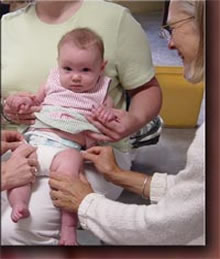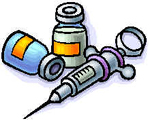Children need love and their shots on time. ..Immunizations are an important part of your child’s total health care. Immunize your child on time,and keep One of the most important part of well being is to be protected and safe. Immunizations also called vaccines provide protection against serious diseases and they also help reduce the spread of disease to others. • Immunizations have greatly reduced the ocurrence of epidemics. Vaccines are safe, and scientists continually work to make sure they become even safer. Immunizations are made of either weakened or "killed" versions of the bacteria or virus that causes a particular disease. When these altered viruses and bacteria are injected into the body (or, in the case of the rotavirus vaccine, taken orally), the immune system mounts an attack that stimulates the body's production of antibodies. Once produced, these antibodies remain active in the body and will be ready if your child is ever exposed to the real disease. Children should receive most of their immunizations during the first two years of life, starting at birth. Doses cannot be given too close together or immunity doesn’t have time to build up. Boosters are given before children go to school. Children who are behind on getting their shots are at risk and need to catch up on immunizations to be protected. • Which immunizations are recommended and when are they given? These immunizations are recommended by the American Academy of Pediatrics (AAP) and the U.S. Centers for Disease Control and Prevention (CDC):
At birth, infants have protection against some minor infections because antibodies have passed through the placenta from the mother to the unborn child. After birth, breastfeeding is the best nutrition for the baby and breastfed babies get the continued benefits of additional antibodies in breast milk, but it does not prevent serious infections and does not protect a child from the diseases preventable by vaccines. A newborn needs to receive the first HepB -hepatitis B- shot within 12 hours after birth,at any time prior to leaving the hospital. The second shot is given at 2 months in conjunction with other routine childhood immunizations.
2 Months
4 Months • 2nd DTap(Diphtheria-Tetanus-Pertussis whooping cough) 6 Months • 3rd DTap (Diphtheria-Tetanus-Pertussis whooping cough) 12 Months-1st.year • 4 DTap (Diphtheria-Tetanus-Pertussis) 4 - 6 years • 5 DTaP (Diphtheria-Tetanus-Pertussis) 11 -12 years • 1st DTaP ( adult - Diphtheria-Tetanus- Pertussis) or 1dose TD ( Diphtheria-Tetanus every 10 years) 14 -18 years
• 2 Hep A and 3 Hep B series completed If you have any questions, please make an appointment with your child's pediatrician so he or she may answer your questions, or call the County's Health Department immunization office at (619) 692-8661, or visit www.sdiz.org. • Protect your baby by taking him to be vaccinated. >>> • Free and Low-Cost Clinics(County of San Diego www.sdiz.org) • County of San Diego Immunizations Schedule easy to read in English and Spanish (PDF) • CDC Recommended Immunization Schedules for Persons Aged 0– 18 Years Booklet (PDF) • Vaccines More Frequently Asked Questions(County of San Diego) • Understanding Vaccines & their Purpose CDC) • The ABCs of Childhood Vaccines (CDC) • Why does my child need to be immunized?(American Academy of Pediatrics AAP) This article is for educational purposes only. For specific medical advice, diagnoses, and treatment, consult your doctor. The information in the article was in part excerpted from the County of San Diego HHSA Immunization Branch website: www.sdiz.org. The Immunizations Schedule Information is reprinted from The American Academy of Pediatrics and U.S. Department of Health and Human Services Centers for Disease Control and Prevention Recommended Immunizations Schedule 2008, revised for its publication by Dr.Ernesto Plazola G., M.D.,PhD. in pediatrics, Editor-in-Chief Salud+Health Info Publication 2008. |
|
TEL- 619-427-4111 Email - Health@infooption.com Salud+HealthInfo is for information and educational purposes only. You should not rely on this information as a substitute for personal medical attention, diagnosis or hands-on treatment. If you are concerned abut your health or that of a child, please consult your family's physician or health provider immediately and do not try to diagnose yourself. Copyright © 2001-2008 Info Option Network |
|
Bienvenido a la primer revista dedicada al cuidado de la salud
 info
info
The first, the best & the only English & Spanish Magazine in San Diego, California

 your child’s immunization record up-to-date.
your child’s immunization record up-to-date. Birth
Birth • 1st DTap (Diphtheria-Tetanus-Pertussis whooping cough)
• 1st DTap (Diphtheria-Tetanus-Pertussis whooping cough) 
